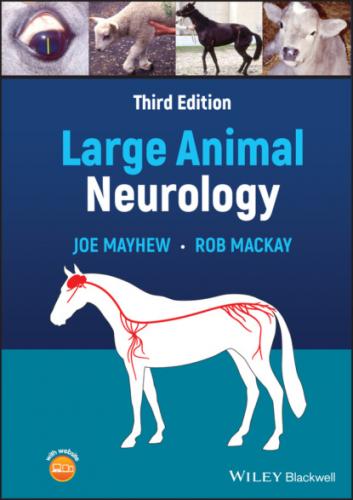1 NAV. Nomina Anatomica Veterinaria, International Committee on Veterinary Gross Anatomical Nomenclature (ICVGAN). 2017
2 OED. Oxford English Dictionary. Oxford University Press, Oxford. 2009
3 Radostits OM, Mayhew IG, and Houston DM . Veterinary Clinical Examination and Diagnosis. WB Saunders, London. 2000
About the companion website
Don’t forget to visit the companion website for this book:
www.wiley.com/go/mayhew/neurology
There you will find valuable materials, including:
Video clips presenting a wide variety of diseases that show actions, movements, postures, and syndrome characteristics of the disorders
Figures from the book as downloadable PowerPoint slides
Scan this QR code to visit the companion website
1 Practical neuroanatomy
Disease
Basic descriptive terminology Functional neuroanatomy
Some of the most rewarding aspects of clinical neurology involve being able to associate observed signs and syndromes with neuroanatomic sites of the lesions. This may, for example, be experienced when recognizing a syndrome of ataxia in a purebred patient and associating it with a familial cerebellar disorder for a client. Alternatively, one may be able to explain to a producer how a certain lesion, detected by an astute neurologic examination of one representative animal and confirmed at postmortem examination is the cause of the clinical syndrome observed in the herd. The basic requirement for achieving this degree of diagnostic acumen is an understanding of applied neuroanatomy.
This chapter provides the basic information necessary to allow the clinician to appreciate the fundamentals of a neurologic examination and to interpret, accurately, the results of such an examination. As the clinician becomes adept at these tasks, further anatomic details may be sought. These can be found in the texts listed in the references.
At this point, a plea is made for a clear use of anatomic terms, based on Nomina Anatomica Veterinaria, Nomina Embryologica Veterinaria and Nomina Histologica, 1 along with the clinically applied terms used in functional neuroanatomy,2–4 clinical neurology,5–7 and veterinary neuropathology.8–10
Basic descriptive terminology
The following is a review of basic descriptive terminology; note that the derivation, abbreviation, combining form, synonym, or explanation is given parenthetically.
The central nervous system (CNS) consists of the brain (encephalo) (Figure 1.1) and spinal cord (myelo). It contains collections of neuronal cell bodies or somata in layers (laminae), nuclei, and columns of gray matter (polio). Tracts, sheets, and pathways of dendritic (afferent) and particularly axonal (efferent) processes of these cell bodies make up the white matter (leuko). These processes make up most of the CNS along with their fatty, myelin (myelino) coats. In tall, large animals, some of these neuronal fibers extend 2–3 m, and many exit and enter the CNS via the cranial and spinal nerves of the peripheral nervous system (PNS).
Figure 1.1 Basic areas of the brain can be readily recognized on this diagram of a median section of a horse brain. The terminology used in this book is shown. Wherever possible the authors use the terminology of Nomona Anatomica Veterinaria;
however, some license is taken with respect to forebrain, which here refers to the prosencephalon plus diencephalon, as clinically, lesions in these collective regions generally present the same syndromes. It is important to recognize these various areas when sending brain sections for histopathologic examination.
Structurally, the forebrain (prosencephalon) is composed of the cerebral hemispheres (most of the telencephalon), thalamus and hypothalamus (diencephalon), hippocampus, basal nuclei, and the limbic system, all situated in the rostral fossa of the neurocranium. The middle fossa contains the midbrain (mesencephalon). Caudally, the hindbrain (rhombencephalon) is composed of the cerebellum and pons (together with the metencephalon) and the medulla oblongata (myelencephalon) that all reside in the caudal fossa. Both the cerebrum (cerebro) and cerebellum (cerebello) have their own outer (cortical) and inner (medullary) portions, composed particularly of gray matter (neuronal cell bodies) and white matter (neuronal fibers), respectively. The remainder of the brain comprising the midbrain, pons, and medulla oblongata makes up the brainstem. This contains white matter pathways passing to and from brain and spinal cord regions, and gray matter, mostly contained in nuclei as relay centers and sensory and motor nuclear areas for the body, including the cranial nerve nuclei.
The spinal cord is the conduit between the brain and the peripheral spinal (non‐cranial) nerves and their innervated structures of the body. Thus, it contains all the afferent and efferent neuronal fibers connecting to and from the brain as superficial white matter tracts. It has a cervicothoracic (brachial) enlargement (intumescence) and a lumbosacral (pelvic) enlargement at the levels of the thoracic and the pelvic limbs, respectively. These swellings are the result of a higher density of neuronal cell bodies at these sites, collected in the butterfly‐shaped, central gray matter and supplying the sensory and motor spinal nerves for the limbs.
To avoid some confusion, vertebral levels are labeled as C7, T3, L4, S5, Ca6 (caudalis as opposed to coccygeal), etc., and spinal cord segments are labeled as C8, T3, L4, S5, Ca6, etc.
Clinically, the autonomic nervous system functions independently and involuntarily from the rest of the nervous system, receiving afferent input from the environment via the basic and special senses to maintain the body’s internal milieu. The parasympathetic component has a brainstem and sacral outflow to the head and body, whereas the sympathetic component has a thoracolumbar outflow.
The entire CNS is protected within the bony neurocranium of the head and in the vertebral canal within the vertebral column. It is covered by meninges consisting of the thick (pachy) dura mater and thin (lepto) arachnoid and pia mater. Between the latter two membranes, is cerebrospinal fluid (CSF), produced by the choroid plexuses of the lateral and fourth ventricles. This fluid also fills the cavities within the brain (ventricles) and spinal cord (spinal canal), which
